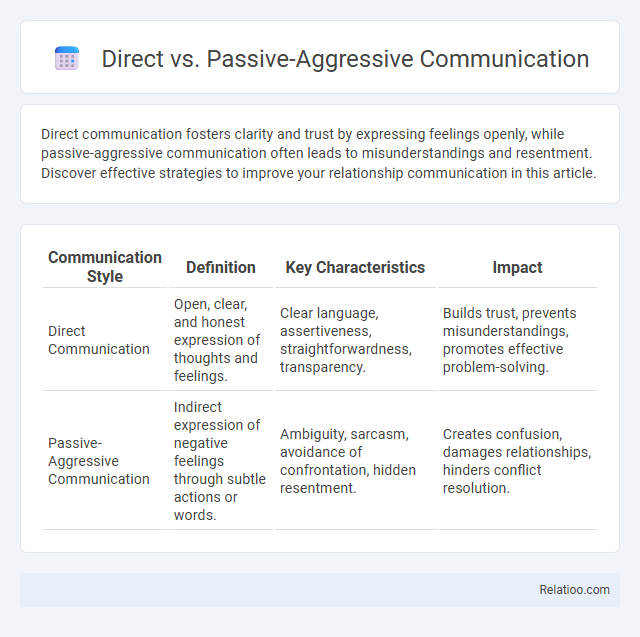Direct communication fosters clarity and trust by expressing feelings openly, while passive-aggressive communication often leads to misunderstandings and resentment. Discover effective strategies to improve your relationship communication in this article.
Table of Comparison
| Communication Style | Definition | Key Characteristics | Impact |
|---|---|---|---|
| Direct Communication | Open, clear, and honest expression of thoughts and feelings. | Clear language, assertiveness, straightforwardness, transparency. | Builds trust, prevents misunderstandings, promotes effective problem-solving. |
| Passive-Aggressive Communication | Indirect expression of negative feelings through subtle actions or words. | Ambiguity, sarcasm, avoidance of confrontation, hidden resentment. | Creates confusion, damages relationships, hinders conflict resolution. |
Understanding Direct Communication
Direct communication involves clear, straightforward expressions of thoughts and feelings, promoting transparency and reducing misunderstandings. It enhances workplace efficiency by encouraging openness, fostering trust, and facilitating quick resolution of conflicts. Mastering direct communication skills leads to stronger relationships and improved collaboration across diverse teams.
Defining Passive-Aggressive Communication
Passive-aggressive communication is characterized by indirect expressions of hostility, such as sarcasm, procrastination, or stubbornness, rather than openly addressing issues. Unlike direct communication, which is straightforward and clear, passive-aggressive communication often creates confusion and mistrust as underlying feelings remain unspoken. Understanding this style is crucial for improving interpersonal interactions and resolving conflicts effectively.
Key Differences Between Direct and Passive-Aggressive Communication
Direct communication involves clear, honest expression of thoughts and feelings, fostering transparency and mutual understanding, while passive-aggressive communication masks true intentions with sarcasm, avoidance, or subtle sabotage, leading to misunderstandings and unresolved conflicts. Your ability to recognize these key differences empowers you to choose communication styles that promote respect, clarity, and effective problem-solving in personal and professional relationships. Opting for direct communication helps you build trust and reduces emotional tension compared to passive-aggressive behaviors that often disrupt dialogue and damage rapport.
Common Traits of Direct Communicators
Direct communicators express thoughts and feelings openly and honestly, prioritizing clarity and transparency in their messages. Your communication style reflects confidence and respect, avoiding ambiguity and minimizing misunderstandings. This approach fosters trust and efficiency, as direct communicators tend to address issues straightforwardly without hidden meanings or indirect cues.
Signs of Passive-Aggressive Behavior
Passive-aggressive communication is characterized by indirect expressions of anger or frustration, such as sarcasm, sulking, or backhanded compliments. Signs of passive-aggressive behavior include procrastination, intentional inefficiency, and subtle sabotage, often leaving Your concerns unaddressed or ignored. Unlike direct communication, which is straightforward and clear, passive-aggressive communication obscures true feelings, creating confusion and tension.
Benefits of Direct Communication
Direct communication enhances clarity by explicitly expressing thoughts and expectations, reducing misunderstandings and fostering transparency. It promotes efficient problem-solving and strengthens relationships through open dialogue and mutual respect. This communication style supports accountability and builds trust, creating a more positive and productive environment.
Negative Impacts of Passive-Aggressive Communication
Passive-aggressive communication often leads to misunderstandings, decreased trust, and unresolved conflicts within personal and professional relationships. By expressing negative feelings indirectly, Your message becomes unclear, fostering frustration and resentment among recipients. This communication style undermines effective collaboration and emotional well-being, making it essential to recognize and address passive-aggressive behaviors promptly.
Real-Life Examples: Direct vs Passive-Aggressive Responses
Direct communication involves expressing your thoughts and feelings clearly and respectfully, such as saying, "I'm upset that the project deadline was missed." Passive-aggressive communication, by contrast, often hides true feelings behind sarcasm or subtle digs, like stating, "Nice job on the deadline, as usual," which can create confusion and tension. Understanding these real-life examples helps you recognize when someone is being honest versus indirectly hostile, improving workplace and personal interactions.
Tips to Shift from Passive-Aggressive to Direct Communication
Shifting from passive-aggressive to direct communication involves practicing clear, honest expression of feelings and needs while maintaining respect for others. Use "I" statements to own your emotions and avoid blame, such as "I feel upset when meetings start late." Regularly reflect on your communication style and seek feedback to build confidence and reduce indirect behaviors.
Choosing the Right Communication Style for Healthy Relationships
Choosing the right communication style is essential for fostering healthy relationships, with direct communication offering clarity and reducing misunderstandings. Passive communication often leads to suppressed feelings, while passive-aggressive behavior causes confusion and resentment. Understanding your communication preferences and expressing yourself openly can strengthen trust and improve emotional connections.

Infographic: Direct vs Passive-aggressive communication
 relatioo.com
relatioo.com